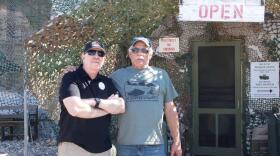WWII came to the Central Coast with segregated 54th Coast Artillery and internment of Japanese residents.
Associate Producer Ruth Carlson reports from Camp San Luis Obispo where she met up with military historian Lt. Col. Erik Brun.
The Japanese attack on Pearl Harbor in December 1941 was only part of the story that Brun has been chronicling for the California State Guard’s Military History Command.
In 1942, San Luis Obispo County’s population had almost tripled with the arrival of almost 100,000 soldiers arriving for training at Camp San Luis Obispo and Camp Roberts. Santa Maria airfield served as a training base for B-25 Mitchell bomber pilots. A new base west of Lompoc, Camp Cooke (present day Vandenberg) would soon house an additional 40,000 soldiers.
Brun‘s research includes the role of black service members in San Luis Obispo County with a focus on the segregated USOs on Morro and Higuera Streets in San Luis Obispo and the evolution of Japan town at South and Higuera Streets that morphed into the hub of the black community during WWII and postwar years.

Brun was a presenter at the WWII Commemoration programs hosted by SLO History Center last year and is presently working on projects such as the Black History Month presentation for the CC Veterans Memorial Museum addressing the Segregated 54th Coast Artillery in SLO County in WWII, scheduled for February 28th at 2pm.
Lt. Col. Erik Brun began his career in Santa Barbara joining the National Guard in 1979. He deployed to Saudi Arabia, Kuwait, and Iraq during the Gulf Wars. He has lived on the Central Coast on and off since the mid-1980s and is now a resident of Morro Bay. Both He and his wife Lt. Col. Heidi Brodmarkle-Brun retired from the army after a combine 60 years of service in 2018.
Funding for Journeys of Discovery with Tom Wilmer is provided by the Foundation at Hearst Castle

Conserving the past to inspire future generations of dreamers and preserving the legacy of Julia Morgan.
Experience authentically curated historical events that recreate what it was like to be a guest of William Randolph Hearst. Learn more about becoming a supporting member of the Foundation at Hearst Castle.

You are invited to subscribe to the six time Lowell Thomas Award-winning travel podcast, Journeys of Discovery with Tom Wilmer, featured on the NPR Podcast Directory, Apple Podcast, the NPR One App Stitcher.com and more than twenty other podcast hosting sites including iHeartRadio and Spotify













